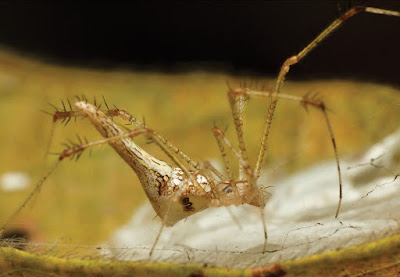 |
| Meotipa sahyadri
Kulkarni, Vartak, Deshpande & Halali, 2017
|
Abstract
A characteristic new species Meotipa sahyadri n. sp. with tall and white translucent abdomen in females is described in detail based on morphology of both sexes, based on specimens collected from the Western Ghats of Maharashtra, Gujarat and Goa. The new species has epigynal projection which is known only in Meotipa picturata Simon, 1895, but differs in shape (trifid vs. quadrangular respectively). Males have longest straight embolus exceeding conductor length. Observations of its natural history are provided. Meotipa picturata is newly recorded from Goa, which extends its north-westward distribution from the previously known records from ‘Kodei Kanal’, India (type locality), Ratchasima Province, Thailand and East Kalimantan, Indonesia. A new combination Meotipa andamanensis (Tikader, 1977) n. comb. (=Argyrodes andamanensis) is proposed based on the comparison of description and illustrations provided in the original paper to that of the characters of the type species M. picturata. 242 morphological characters studied in the previous literature and one additional character ‘epigynal projection’ were scored for Meotipa sahyadri n. sp. and Meotipa picturata. These species were obtained monophyletic, placed within Theridiinae as sister to Chrysso cf. nigriceps using parsimony analysis and Bayesian inference.
Keywords: Araneae, Taxonomy, Comb-footed Spiders, Morphology, Phylogeny, Asian Tropics, Western Ghats
 |
| Meotipa sahyadri n. sp., live female; unknown deposition in translucent part of abdomen. |
Meotipa sahyadri new specie
Diagnosis. The exceptionally tall and thin abdominal projection is characteristic for female Meotipa sahyadri n. sp. (Figs. 12, 13). This species is morphologically and geographically distributed close to Meotipa picturata; morphologically for presence of rod-shaped projection in epigynal atrium, but distinguishable by its trifid (Figs. 19, 22) (vs. flat, quandrangular (Figs. 43, 44)) shape, shorter and wider copulatory ducts (vs. narrow, long) and spermathecae being separated by less than their diameter. Copulatory duct 2.1 times longer than spermatheca width (Figs. 18, 23) (vs. 3.5 times longer (Figs. 42)). Width of epigynal projection at tip 0.5 times atrium radius (Fig. 22), (vs. equal to atrium radius (Fig. 43)). Males of M. sahyadri n. sp. have straight embolus (Figs.29–31) (vs. coiled in Meotipa bituberculata Deeleman-Reinhold, 2009, Meotipa impatiens Deeleman-Reinhold, 2009) exceeding 1.7 times conductor length (vs. about 1.3 times in Meotipa spiniventris (O. Pickard-Cambridge, 1869), 1.1 times in Meotipa vesiculosa Simon, 1895, receding in Meotipa argyrodiformis (Yaginuma, 1952), Meotipa pulcherrima (Mello-Leitão, 1917) and Meotipa thalerorum Deeleman-Reinhold, 2009).
Etymology. The species is named after ‘Sahyadri’ (noun in apposition), a Sanskrit vernacular name for the northern Western Ghats which comprise all localities of the new species.
Diagnosis. The exceptionally tall and thin abdominal projection is characteristic for female Meotipa sahyadri n. sp. (Figs. 12, 13). This species is morphologically and geographically distributed close to Meotipa picturata; morphologically for presence of rod-shaped projection in epigynal atrium, but distinguishable by its trifid (Figs. 19, 22) (vs. flat, quandrangular (Figs. 43, 44)) shape, shorter and wider copulatory ducts (vs. narrow, long) and spermathecae being separated by less than their diameter. Copulatory duct 2.1 times longer than spermatheca width (Figs. 18, 23) (vs. 3.5 times longer (Figs. 42)). Width of epigynal projection at tip 0.5 times atrium radius (Fig. 22), (vs. equal to atrium radius (Fig. 43)). Males of M. sahyadri n. sp. have straight embolus (Figs.29–31) (vs. coiled in Meotipa bituberculata Deeleman-Reinhold, 2009, Meotipa impatiens Deeleman-Reinhold, 2009) exceeding 1.7 times conductor length (vs. about 1.3 times in Meotipa spiniventris (O. Pickard-Cambridge, 1869), 1.1 times in Meotipa vesiculosa Simon, 1895, receding in Meotipa argyrodiformis (Yaginuma, 1952), Meotipa pulcherrima (Mello-Leitão, 1917) and Meotipa thalerorum Deeleman-Reinhold, 2009).
Etymology. The species is named after ‘Sahyadri’ (noun in apposition), a Sanskrit vernacular name for the northern Western Ghats which comprise all localities of the new species.
Siddharth Kulkarni, Atul Vartak, Vishwas Deshpande and Dheeraj Halali. 2017. The Spiny Theridiid Genus Meotipa Simon, 1895 in India, with Description of A Strange New Species with Translucent Abdomen and A Phylogenetic Analysis about the Genus Placement (Araneae, Theridiidae).
Zootaxa. 4291(3); 504–520. DOI: 10.11646/zootaxa.4291.3.4
Zootaxa. 4291(3); 504–520. DOI: 10.11646/zootaxa.4291.3.4